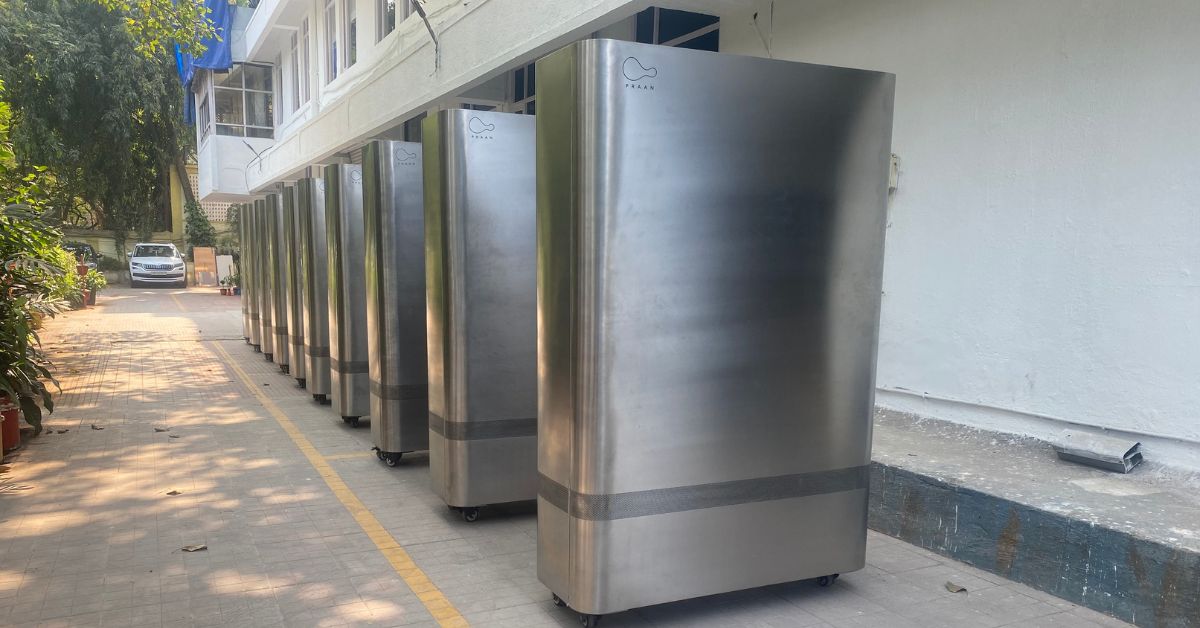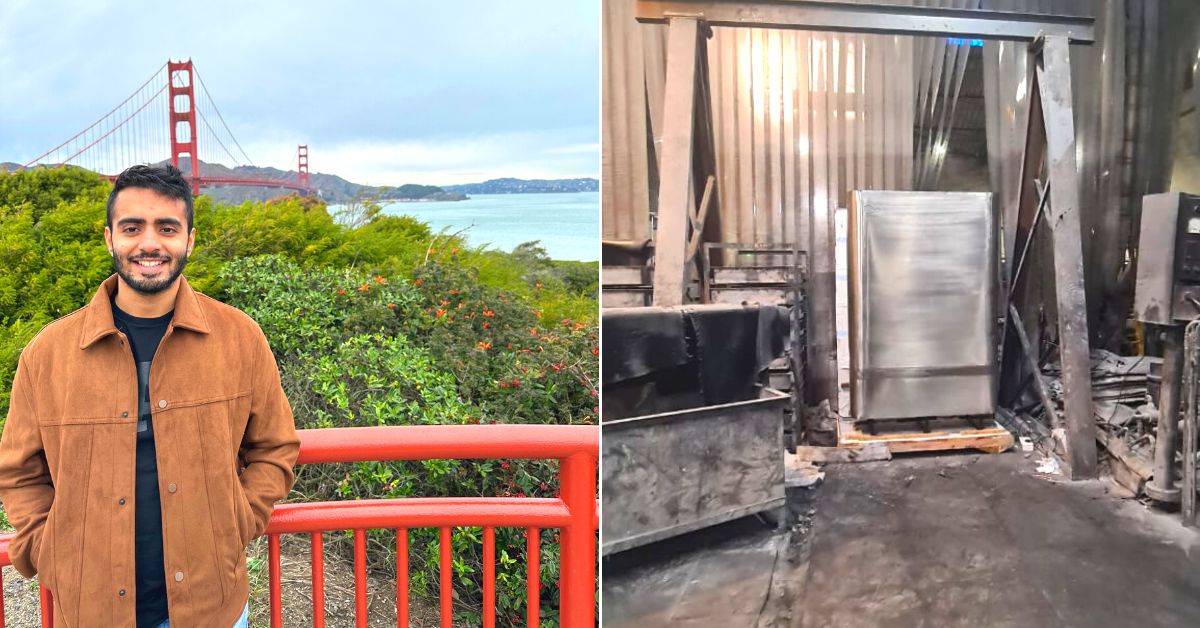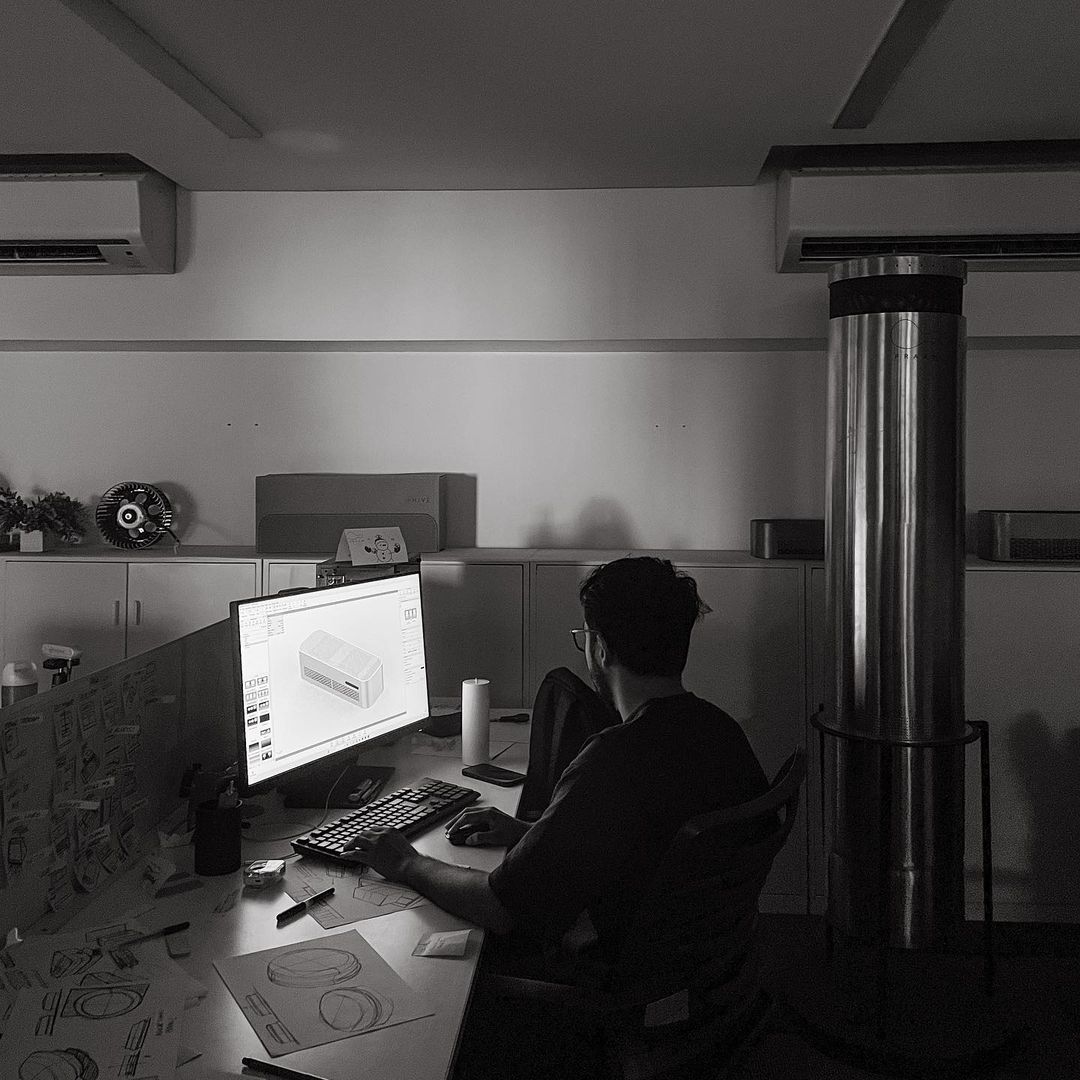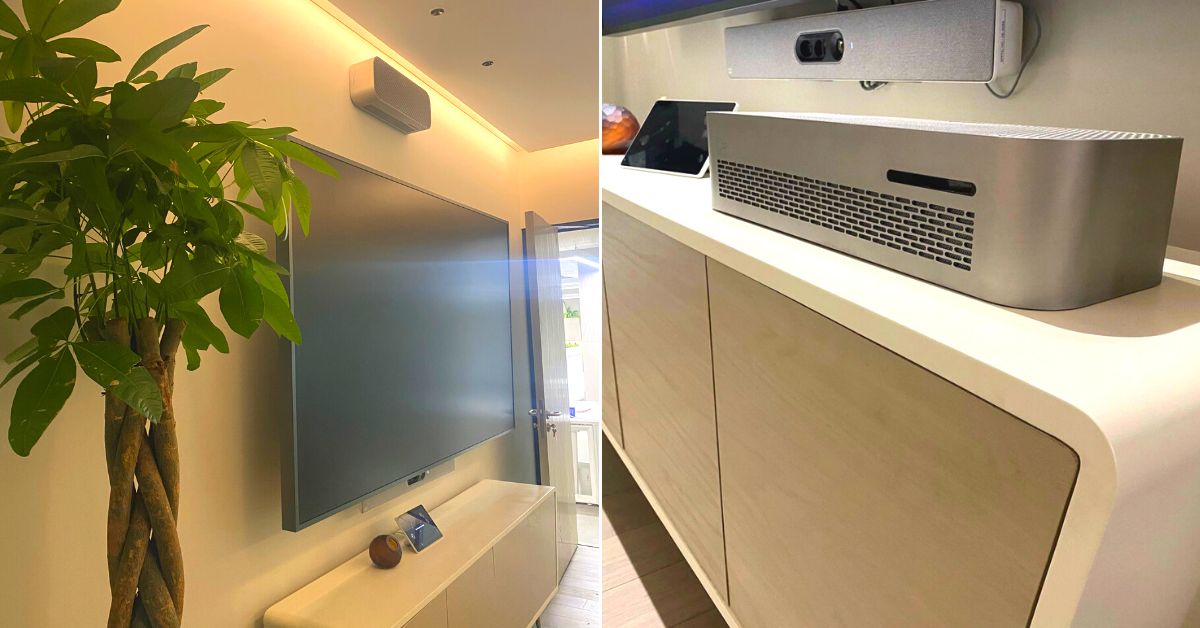Angad Daryani, the 25-year-old founding father of Praan, Inc., a deep-tech startup based mostly out of Mumbai, is a part of a technology that grew up with a actuality of a bleak future—one plagued with air pollution and local weather change.
“Earlier generations grew up with the promise of an thrilling future the place In the event you labored exhausting and constructed a profession, [the expectation was that] the long run could be nice. However our technology grew up with the fact of local weather change, animal extinction, and extreme air and water air pollution. Since I used to be about six years previous and realized about these items on Nationwide Geographic, this discomfort a few bleak future has stayed with me,” explains Angad, in a dialog with The Higher India.
Fixing real-world issues has at all times excited him. A toddler prodigy from Mumbai, Angad constructed his first robotic and a solar-powered boat at age 8, apart from constructing a homegrown 3D printer by 13 and an e-reader (Digital Brailler) for the visually-challenged by 15. He briefly dropped out of the education system due to his disillusionment with the rote learning-based state board system.
“I discovered college complicated. Whereas I used to be doing properly academically, the rote-based schooling didn’t construct my fundamentals which might turn out to be apparent once I’d compete in Olympiads and battle to resolve issues. Concurrently a interest, I used to be constructing all these complicated engineering initiatives at residence alone just by watching movies or studying books. Once I dropped out of college, my dad and mom employed a tutor who would educate me all the identical issues as different highschool college students, whereas rebuilding my fundamentals. Since I didn’t have homework and was fixing issues whereas studying the subjects, I had a number of free time to deal with my scientific hobbies.” he remembers.
Throughout this time, when Angad was round 14 years previous, he wrote an e-mail to Professor Ramesh Raskar, an Indian-born professor on the Massachusetts Institute of Know-how (MIT). Presently, he’s an Affiliate Professor of media arts and sciences on the famend MIT Media Lab and an advisor to famend expertise giants like Google and Apple.
“It’s amusing wanting again at my ignorance, however I wrote to him saying, ‘You might be an Indian professor and MIT brings vivid younger college students from around the globe to its campus, so why not carry on somebody from India?’ Extremely, he wrote again nearly instantly and I ended up working with MIT through their India Initiative for 2 years constructing expertise that might remedy real-world issues in well being tech. Even until this present day, Professor Raskar stays supportive of my journey and has been an unbelievable mentor” he remembers.
After these two years working with MIT, he went again to an IB (Worldwide Baccalaureate) college, following which he studied electrical engineering on the prestigious Georgia Institute of Know-how (Georgia Tech). It was throughout his time in faculty when he determined to behave on the rising drawback of air air pollution and started creating options for it.
As we speak, his startup has constructed one of many “world’s most superior air purification applied sciences” utilizing a singular mixture {of electrical} cost dispersion and airflow optimization-based processes – permitting particles to be charged and creating electrical fields that transfer the particles to a set chamber. Angad mixed his background in electrical engineering, product design, IoT, course of engineering, and manufacturing to create a complete new class of air purifiers.
Briefly, his resolution works via a community of air purifying models that may clear air inside massive areas like manufacturing facility flooring in simply minutes by mapping how the air pollution is flowing on the store flooring after which strategically putting the air purifiers to seize that air pollution. For instance, Praan’s newest product known as the MK II (‘Mach 2’) has a excessive purification price of 1300 cubic toes per minute.

Impressed by sickness
Rising up in Mumbai, Angad suffered from bronchial asthma. Each winter, significantly through the festive season, he would endure respiratory difficulties on account of excessive air air pollution and his household must depart the town.
“With bronchial asthma and excessive mud ranges within the metropolis, I’d battle to play soccer. I couldn’t run correctly as a result of my stamina would take a success and I’d cough consistently. However this was a actuality for lots of people residing round me. As we speak, whereas I can transfer to a rustic with a cleaner atmosphere, I can’t count on my household and buddies to do the identical. I couldn’t see them breathe this poisonous air daily and for this reason discovering an answer was so necessary to me,” remembers Angad.
In 2017, simply earlier than he started his sophomore yr at Georgia Tech, he started engaged on options for city air air pollution however this got here with some actual challenges.
“If I used Georgia Tech’s infrastructure to construct my resolution, as per the clauses, they’d personal all of the mental property. In consequence, I wouldn’t have the liberty to commercialise it as per evolving necessities. And therefore, commercially, we didn’t have entry to any of their labs. Additionally, because of my visa standing, I legally couldn’t register an organization and begin a enterprise with a co-founder there whereas being a school pupil,” he remembers.
“And the reality about constructing air purification expertise is that it’s not simply the air purifier or the sensor you’re constructing, however you’re additionally constructing the infrastructure to check it in numerous wind, temperature, humidity, and air pollution situations. Given the shortage of economic sources through the bootstrap part, it was fairly exhausting to construct a protected check chamber that might work in all these totally different situations, present correct and dependable knowledge and can help you check with all totally different supplies of mud, gases and pollution,” provides Angad.
In consequence, Angad began constructing the prototypes of those filterless purification techniques based mostly on physics rules out of his condo room close to Georgia Tech the place fundamental traits may very well be inspected visually.
In response to this detailed description on Praan’s web site, “He would carry the prototype for two miles a number of occasions each week from his condo to the on-campus makerspace to construct the earliest variations of a filterless air purification system. The machine first began with a paint-bucket prototype after which made it to a metal ducting system model.”
“As he continued to work on it, increasingly college students round campus would discover him strolling throughout the garden with this 5ft-tall metallic construction which regarded like a jet engine. Out of curiosity, they’d discuss to him,” it provides.
A few weeks later, nonetheless, CNN reached out to him to interview for his or her ‘Tomorrow’s Hero’ sequence. Following discussions over e-mail, they got here all the way down to the Georgia Tech campus and shot a video with him the place they mentioned his mission, method and the expertise he was constructing to deal with city air air pollution. CNN finally recorded and revealed this text and video which went viral very quickly.
It’s necessary to notice, nonetheless, that Angad wasn’t initially all for constructing your typical indoor air purifiers you could set up at residence.
“Regardless of the business attraction, I resisted creating a standard indoor air purifying system. I used to be not fascinated with the highest 1% who can afford a Dyson however that baby who walks to highschool daily or a manufacturing facility employee inhaling poisonous air throughout his/her shifts. My goal was to seek out one thing that may be completed for big areas,” he says.
“One other necessary aspect was to not contain filters. If I hold a filter-based air air purifier at a big area in Delhi through the winter one must change the filter each hour. I wished to construct a filterless system, which implies no recurring price of possession in these massive areas,” he provides.

Energy of volunteers
A few months after his look on CNN, Angad returned to India for the summer season the place he continued to work on prototyping the units and testing them in India.
Because the Praan web site notes, “Since this mission was completely bootstrapped with no exterior financing, all of the prototyping was completed with off-the-shelf parts and built-in Angad’s bed room and terrace in Mumbai, every prototype was hand constructed, lower, glued, soldered, and examined outside. Throughout this course of, he saved posting photos of his progress on the web.”
The reason goes on so as to add, “Deeptech was nonetheless new in India and therefore the provision of threat capital was bleak. So Angad needed to bootstrap the mission and noticed 30 extra volunteers be part of him in his mission as he returned to Atlanta within the Fall 2018. This crew was essentially attempting to determine if filterless air purification utilizing chilly plasma expertise was doable and was alternatively additionally experimenting with bioengineering strategies for purifying air in cities.”
Since his crew didn’t have an workplace or entry to capital, all experimenting of the core tech was completed in public parking heaps or park benches in Atlanta throughout after-hours or on weekends. After a few months, Angad and his crew of over 30 volunteers developed the primary prototypes for filterless air purification units and realized tips on how to design check rigs for constructing these techniques – a course of they are saying they proceed to invent and study from even in the present day, 6 years later.
This was additionally the time when the mission acquired the title ‘Praan’. Throughout this time, Angad and some members of the crew even reached out to the Ministry of Setting, Forest and Local weather Change in India to suggest a filterless method to out of doors air purification. Following this, in December 2018, they flew to New Delhi and demonstrated the idea for his or her first prototype.
“Quickly after this, the conversations round Praan’s mission grew inside the Georgia Tech and Emory College Campuses, resulting in many extra folks making use of to hitch the crew of volunteers engaged on this mission. In a fraction of weeks, the crew grew to 64 folks within the Spring 2019. This was the most important volunteering crew [that] Praan ever had,” notes the Praan web site.
“To develop filterless massive area air purification expertise, you want individuals with totally different specialisations—mechanical designers, chemical engineers, physicists, full-stack builders and people with an understanding of energy electronics and embedded {hardware}, amongst others. Once I began creating this expertise in my sophomore yr, I knew tips on how to construct prototypes however knew nothing about fluid dynamics,” Angad tells The Higher India.

So, how do you entice pupil volunteers to work in your mission?
“You give them recognition on patents, which could be very priceless for a 3rd or fourth-year engineering pupil. And in case you can provide them actual hands-on expertise, which they’re practising via that semester, they’ve a superb story to inform to job recruiters. Plus, given my prior expertise at MIT and the community I developed there, I knew senior individuals who labored in corporations like Apple, Tesla or SpaceX. I might assist introduce these volunteers to those folks, saying they labored on my mission. For instance, Patrick Finley, the founding father of Lander Challenger, went to work at SpaceX after working as a volunteer for Praan,” he says.
Within the following summer season, Angad returned to India with certainly one of his Educating Assistants (TAs) and ran additional experiments at a retailer room belonging to his father’s firm. In the meantime, Naresh Shahani (at the moment a director at Praan), helped get hold of an unsecured mortgage of $15,000 to fund the analysis and growth. Taken in Angad’s title, this sum was finally doubled and returned in 2021.
Later that summer season, Angad, his TA and two interns put collectively the prototype of what would turn out to be the MKOne Outside Air Air purifier. The plan shifting ahead was that Angad would graduate in 2020, run this firm full-time after graduating, and lift capital. Regardless of his finest efforts, securing funding was a significant problem. By January 2020, buyers hadn’t caught on to the potential of deep tech and the affords on the desk weren’t passable.
Regardless of these challenges, he managed “to pool collectively some smooth commitments value $1.35M from an Indian VC fund and some strategic angels on very unhealthy funding phrases”. As these offers had been being finalised, the COVID-19 pandemic struck and the whole lot fell aside. But to graduate from faculty, he needed to pack the whole lot up and are available again to India whereas finishing on-line courses to get his diploma.
However there was a silver lining. Since folks had been dropping their jobs and internships, there have been many seeking to work on one thing that will advance their careers. Much like what he did earlier, Angad provided recognition on Praan patents to anybody who helped develop the expertise additional both remotely and even as a volunteer.
In whole, Praan managed to onboard about 60 volunteers from a number of time zones who selected to dedicate about 4 months of their time to work on their expertise. Whereas the {hardware} was constructed and developed out of Angad and his intern’s bedrooms in Mumbai, different volunteers from around the globe contributed with their concepts and engineering drawings for his or her prototypes.
In response to the Praan web site, there have been additionally “design groups engaged on concepts for the MK One product, the indoor air purification, bioengineering, carbon seize, and software program engineering merchandise—all with none capital within the financial institution”.
Actual funding and help lastly got here within the type of Emergent Ventures, a fellowship and grant programme run by well-known economist Dr. Tyler Cowen. It gave this fledgling startup the most important grant through the lockdown interval which helped them entry capital to construct prototypes and check rigs as properly. Within the subsequent few months, they developed a working prototype of the MKOne Outside Air air purifier in India.
Nevertheless, there was little or no buyer or investor curiosity and a negligible quantity of distributors had been keen to fabricate the MKOne prototype. Angad spent about 5 months ready for distributors to fabricate the primary usable MKOne prototype. Bored with ready, Angad determined “to construct the primary MKOne prototype at a utensil manufacturing plant.”
Whereas there have been variations between this prototype and future merchandise by way of dimensions and ending, they lastly had an actual product that they might present buyers. Furthermore, it gave the Praan crew actual confidence that they might begin to manufacture this product in India.
How does this expertise work?
Each the MKOne and the newer MK-II Air Purification techniques work on related fundamentals.
Chatting with The Higher India, Angad explains, “Particles are pulled in utilizing followers, charged in a really confined area, instantly separated from the air stream after which pushed down utilizing pulses into a set bucket. Merely put, it actively pulls polluted air from the highest, separates the particulate matter utilizing Praan’s patent-pending filterless expertise, collects it in a set tray and releases cleaner air again into the hyperlocal environment via the retailers.”
“The MKOne was designed for particulate matter concentrations of as much as 1000 ug/m3 whereas the MK-II manages AQI as much as 40,000 ug/m3. The MK-I used to be designed for out of doors functions–constructing compounds, frequent areas, college compounds, and so forth. The MK-II machine was designed for industrial use circumstances—manufacturing facility flooring the place there are extremely excessive mud volumes and ranges. MKOne’s triangular design was for early prototypes since that was a comparatively simple form to fabricate. Nevertheless, the cylinder is the most effective form to make sure that the machine doesn’t topple when positioned exterior in excessive wind situations,” provides Angad.
MKOne was first proven to the world in December 2020. The MK-II was designed and soft-launched in December 2023, and commercially launched in July 2023.

“MK-II has eight occasions the purification capability and 5 occasions the storage capability of MKOne,” he claims.
Praan has additionally developed HIVE, an indoor air air purifier. Angad claims, “The HIVE software program and the EDITH AI assist that Praan supplies ensures that your air is at all times clear. Furthermore, all upkeep is managed by us.”

Lastly, on the subject of buyers, suffice to say that Praan has to this point raised a complete of $1.9 million from VCs and Angel buyers starting from the New York-based Social Impression Capital, which, amongst others, has PayPal co-founder Peter Thiel as a backer. Moreover, they’re supported by Microsoft, Autodesk and the Marico Innovation Basis.
Trying forward, Angad has laid out his blueprint for the long run.
“Praan began with the imaginative and prescient of constructing the long run extra thrilling by making certain that clear air is accessible to all. We are going to scale to make industrial, residence, business, and out of doors merchandise in air purification and mapping—each in {hardware} and AI-run software program. We can even scale direct air elimination of carbon dioxide outside and indoors for carbon credit score technology and everlasting storage of CO2. Our bio-engineering crew has and can proceed to rebuild ecosystems whereas making certain greenhouse gasoline elimination around the globe,” he says.
(Yow will discover out extra about Praan.io and their work right here.)
(Edited by Padmashree Pande; Photos courtesy Praan)
